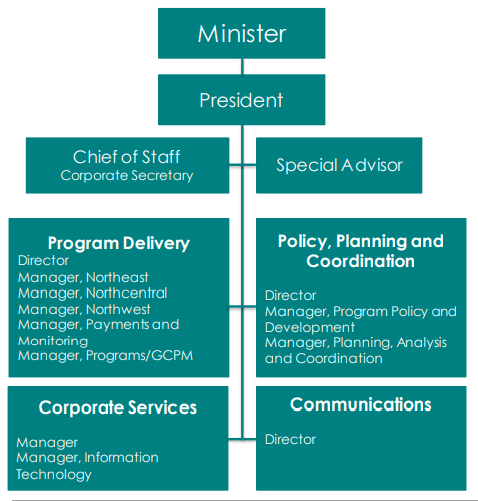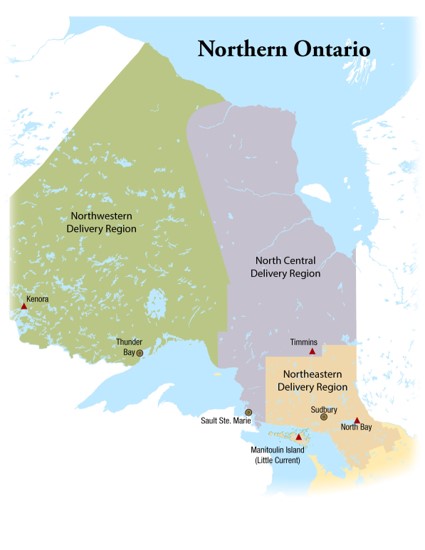Download the printer-friendly version (PDF)
Table of contents
- Mandate
- FedNor responds according to Northern Ontario’s specific issues
- Community/Sectoral Impacts of COVID-19
- How our programs adapt
- Our core programs
- Our temporary programs
- Priorities driven by regional realities
- Our clients: SMEs and the organizations that support them
- Success stories
- How do we add value?
- Results and impacts in 2020-2021
- Key messages
- FedNor, in brief
Mandate
FedNor was first created as a federal initiative in 1987 with a mandate to assist in the expansion and diversification of the economy of Northern Ontario. On August 12, 2021, FedNor was established as a standalone agency, confirming the importance of its role.
FedNor responds according to Northern Ontario’s specific issues
Contextual issues
Demography
Stagnant population growth
- Population: 877,700 (5.9% ofOntario and 2.3% of Canada)
- Older age profile 65+ (21.7%)
- Almost 60% of populationconcentrated in 5 cities
- Francophone population (121,400) represents 15% of region’s population
- Indigenous population (130,600) represents 16% of region’s population
- Low international immigration
Economy
Concentrated in natural resources with opportunities to diversify
- $37,752M (2019) GDP representing approximately 5% of Ontario’s GDP and 1.9% nationally
- Lower unemployment than national average– but hampered by labour shortage with fewer workers looking for employment
- Over 65,700 businesses; only 68 with over 500 employees
- Approximately 10.5% of Ontario’s exports
Regions
Disparity between urban and rural communities
- Large geography comprising of 90% of Ontario’s landmass
- Significant disparities between large centres, medium-sized cities and rural/remote areas (broadband, sectors, job creation)
- 150 municipalities, of which 80% have a population of 2,000 or less and 105 First Nations communities
Impacts of the pandemic
An economy on pause
- By spring 2021, overall business activity had increased more than the provincial average in many centres, but total employment levels remained below average
- Significant revenue reductions continue for almost half of regional business
A tepid recovery
- Vigilance at the dawn of a 4th wave
- Uncertainty for recovery in accommodation and food services, tourism and retail trade along with single-industry communities
- Historical areas of challenge for Northern Ontario continue to impact development
Community/Sectoral Impacts of COVID-19
Deeply affected sectors with ongoing struggles Deeply affected
- US market reliance, border restrictions and closures
- Signature tourist attractions heavily impacted
- Higher food prices and increased distribution
Mildly affected sectors maintaining a level of activity Mildly affected
- Increased operating costs
- Supply chain interruptions and transportation challenges; re-tooling to supply PPE
- Venture Capital investment down
Growing sectors poised to take advantage of opportunities Growing
- Pause on exploration projects but large recovery innovative opportunities to supply products and support
- Minor early impact on productivity
- Metal prices fell then slight rebound
Regional Sectors
The Far North - Home to 30 Remote First Nations
- Forestry Mildly affected
- Mining Growing
Timmins
- Retail Deeply affected
- Forestry Mildly affected
- Transportation Mildly affected
- Mining Growing
Sudbury
- Retail Deeply affected
- Mining Supply and Services Mildly affected
- Mining Growing
- Health and Life Sciences Growing
North Bay
- Services Deeply affected
- Tourism Deeply affected
- Transportation Mildly affected
- Forestry Mildly affected
- Mining Growing
Muskoka / Parry Sound
- Tourism Deeply affected
- Manufacturing Mildly affected
Sault Ste Marie
- Steel Mildly affected
- Alternative energy Mildly affected
- Forestry Mildly affected
- Information Technology Growing
Thunder Bay
- Tourism Deeply affected
- Manufacturing Mildly affected
- Forestry Mildly affected
- Health and Life Sciences Growing
Kenora
- Tourism Deeply affected
- Forestry Mildly affected
- Mining Growing
How our programs adapt
Government of Canada priorities
- Informs thinking on government priorities
- Implementation based on actual regional needs on the ground
Coordinated response to the extent possible
- Complementarity and synergy of interventions; intersectoral cooperation as well as between different levels of government
Flexibility in the implementation
- Differentiated program modalities according to the areas of intervention
Credible antennas on the ground
- Regional presence
- Local knowledge: regional realities influence how challenges are experienced and addressed
Analytical perspective adapted to the context
- Interventions modulated according to local realities, and for results that respond to real needs
Responsive design of intervention programs and measures
- For a diversified clientele (SMEs, NPOs, communities, clusters, universities, etc.)
- For a variety of projects based on the comparative advantages of the regions
- Through flexible financial tools
Our core programs
- Regional Economic Growth through Innovation (REGI)
- Northern Ontario Development Program (NODP)
- Community Futures Program (CFP)
- Economic Development Initiative (EDI)
Our temporary programs
- Women Entrepreneurship Strategy (WES)
- Regional Relief and Recovery Fund (RRRF)
- Regional Air Transportation Initiative (RATI)
- Black Entrepreneurship Program (BEP)
- Canada Community Revitalization Fund (CCRF)
- Jobs and Growth Fund (JGF)
- Tourism Relief Fund (TRF)
- Aerospace Regional Recovery Initiative (ARRI)
Priorities driven by regional realities
Prosperity and Growth Strategy for Northern Ontario (PGSNO)
A plan for economic development, inclusiveness and success
Supporting Innovation
Growing Companies
Building Stronger Communities
Shared priorities
Strategies/actions
Expand regional ecosystems and clusters
Expand access to capital opportunities
Strengthen linkages
Increase support for incubators, accelerators and innovation hubs
Support competitive businesses reach new markets
Invest in potential growth sectors
Develop and grow Indigenous businesses and women entrepreneurship
Leverage employment opportunities for a bilingual workforce
Build the economic development capacity of rural and Indigenous communities
Invest in key community and regional infrastructure
Develop an attraction and retention strategy for Northern Ontario
Focus youth and skills programs to address gaps
Expected outcomes
Increased exports
Increased technology adoption by companies
More opportunities for Indigenous peoples and enterprises
More opportunities for women entrepreneurs
Value-added jobs
More skilled and trade workers
Communities can better respond to opportunities
Stronger innovation ecosystem
Our clients: SMEs and the organizations that support them
| 1-4 employees | 12,280 |
| 5-9 employees | 5,480 |
| 10-19 employees | 3,880 |
| 20-99 employees | 3,370 |
| 100-499 employees | 475 |
| Proportion of SMEs majority-owned by individuals of Indigenous decent | 4 % |
| Sectors with largest proportion of employment |
|
| Concentrated sectors of activity unique to the region |
|
Types of NPOs supported (Not exhaustive)
- Industrial clusters
- Incubators/accelerators
- Indigenous NPOs
- Tourism industry associations
- Community Futures Development Corporations (CFDCs)
Success stories
Regional Economic Growth through Innovation
Norgalv brought clean advanced galvanizing technology to Northern Ontario (North Bay) thanks to a $1.3 million repayable contribution from FedNor. The funding helped establish a 35,000-square-foot galvanizing plant – the first of its calibre in Ontario and the second in Canada – to service Northern Ontario fabricators in the mining supply and services industry, creating 35 jobs with more expected.
Northern Ontario Development Program
One Human Service Network, launched an innovative digital service that connects parents with childcare service providers thanks to the assistance of a $588,000 repayable contribution from FedNor. With the loan, the small high-tech company in Sault Ste. Marie developed Childcare Connect, a centralized digital platform that helps maximize childcare access, affordability and quality for families and children. As a result the company has created six more highly skilled jobs.
Community Futures Program
Lecours Motor Sales took advantage of a loan from the Northeastern Ontario Investment Pool, administered by the Nord-Aski Regional Economic Development Corporation in Hearst. The Community Futures loan enabled the car dealership to expand its operations and shift gears to design, modify and service hi-rail vehicles. Ten new jobs were created as a result.
Regional Air Transportation Initiative in Northern Ontario
The Thunder Bay International Airports Authority received $3.5 million through FedNor to help it mitigate financial pressures due to the COVID-19 pandemic and enable it to provide service to airlines when travel volumes return. The funding is expected to maintain 27.5 jobs, as well as support regional connectivity and charter service for essential services, including access to remote First Nation communities.
How do we add value?
FedNor projects in fiscal 2020-21 provided well needed relief to businesses and communities to help them survive and be in a position to recover from the COVID-19 pandemic.
This represented:
- $164.9 million in authorized assistance
- 332 projects
Delivered more than 2.5x funding than typical year.
Results and impacts in 2020-2021
Approximately 11,100 jobs were created or maintained as a direct result of FedNor projects including RRRF
Over 3,300 businesses were maintained, expanded or created as a direct result of FedNor projects including RRRF
$1.90 = Amount leveraged per dollar invested in community projects in Northern Ontario
Key messages
- Since 1987, FedNor has served as the Government of Canada's economic development organization for Northern Ontario.
- Through its programs and services, and through its financial support of projects that lead to job creation and economic growth, FedNor works with businesses, organizations and community partners to build a stronger Northern Ontario.
- The creation of FedNor as a Regional Development Agency (RDA) in August 2021 responds to a need identified by Northern Ontario community and business leaders over the years.
- Canada’s RDAs are critical to accelerating recovery efforts, fueling the economy, creating jobs, and maximizing growth opportunities in municipalities and Indigenous communities across the country.
FedNor, in brief

Organizational structure
- Minister
- President (Manon Brassard, FedNor Interim President)
- Chief of Staff Corporate Secretary
- Special Advisor
- Program Delivery
- Director
- Manager, Northeast
- Manager, Northcentral
- Manager, Northwest
- Manager, Payments and Monitoring
- Manager, Programs/GCPM
- Policy, Planning and Coordination
- Director
- Manager, Program Policy and Development
- Manager, Planning, Analysis and Coordination
- Corporate Services
- Manager
- Manager, Information Technology
- Communications
- Director
- President (Manon Brassard, FedNor Interim President)

FedNor currently counts 87 staff across its offices, with its headquarters in Sudbury, and staff in other offices: Sault Ste. Marie, Thunder Bay, North Bay, Timmins, Kenora, and Ottawa.
Text version: Regions of FedNor program delivery area
- Sudbury
- Sault Ste. Marie
- Thunder Bay
- North Bay
- Timmins
- Kenora
- Manitoulin Island (Little Current)
